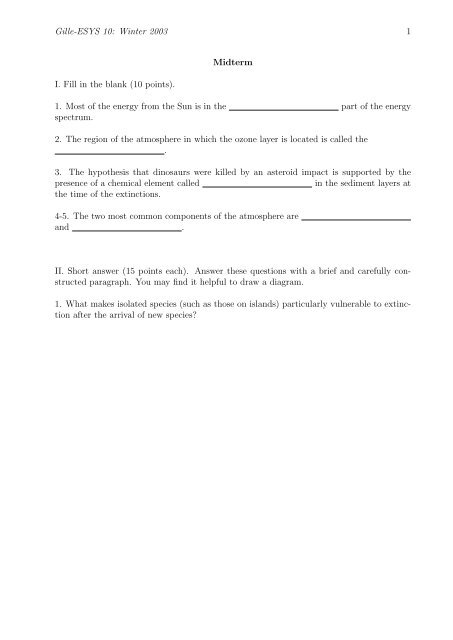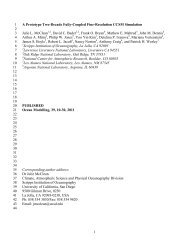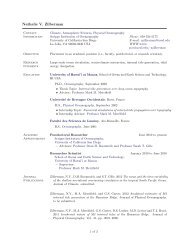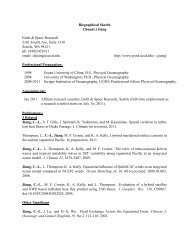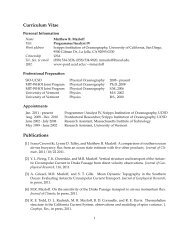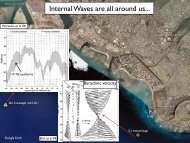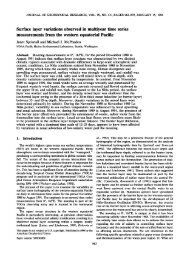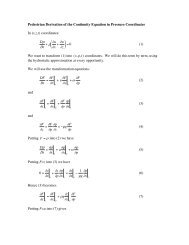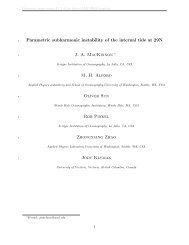Gille-ESYS 10: Winter 2003 1 Midterm I. Fill in the blank (10 points ...
Gille-ESYS 10: Winter 2003 1 Midterm I. Fill in the blank (10 points ...
Gille-ESYS 10: Winter 2003 1 Midterm I. Fill in the blank (10 points ...
You also want an ePaper? Increase the reach of your titles
YUMPU automatically turns print PDFs into web optimized ePapers that Google loves.
<strong>Gille</strong>-<strong>ESYS</strong> <strong>10</strong>: <strong>W<strong>in</strong>ter</strong> <strong>2003</strong> 1<br />
I. <strong>Fill</strong> <strong>in</strong> <strong>the</strong> <strong>blank</strong> (<strong>10</strong> po<strong>in</strong>ts).<br />
<strong>Midterm</strong><br />
1. Most of <strong>the</strong> energy from <strong>the</strong> Sun is <strong>in</strong> <strong>the</strong> part of <strong>the</strong> energy<br />
spectrum.<br />
2. The region of <strong>the</strong> atmosphere <strong>in</strong> which <strong>the</strong> ozone layer is located is called <strong>the</strong><br />
.<br />
3. The hypo<strong>the</strong>sis that d<strong>in</strong>osaurs were killed by an asteroid impact is supported by <strong>the</strong><br />
presence of a chemical element called<br />
<strong>in</strong> <strong>the</strong> sediment layers at<br />
<strong>the</strong> time of <strong>the</strong> ext<strong>in</strong>ctions.<br />
4-5. The two most common components of <strong>the</strong> atmosphere are<br />
and .<br />
II. Short answer (15 po<strong>in</strong>ts each). Answer <strong>the</strong>se questions with a brief and carefully constructed<br />
paragraph. You may f<strong>in</strong>d it helpful to draw a diagram.<br />
1. What makes isolated species (such as those on islands) particularly vulnerable to ext<strong>in</strong>ction<br />
after <strong>the</strong> arrival of new species?
<strong>Gille</strong>-<strong>ESYS</strong> <strong>10</strong>: <strong>W<strong>in</strong>ter</strong> <strong>2003</strong> 2<br />
2. In what ways do <strong>the</strong> climates of Venus and Mars, are nearest neighbors <strong>in</strong> <strong>the</strong> solar<br />
system, differ from that of Earth?<br />
3. If warm<strong>in</strong>g temperatures on Earth were to lead to <strong>in</strong>creased evaporation and heavy cloud<br />
cover, what sort of feedback loop would you expect to see?<br />
4. Air tends to rise at <strong>the</strong> equator and subside around 30 ◦ latitude. Draw a schematic of<br />
<strong>the</strong> circulation. How does <strong>the</strong> Earth’s rotation <strong>in</strong>fluence this process?
<strong>Gille</strong>-<strong>ESYS</strong> <strong>10</strong>: <strong>W<strong>in</strong>ter</strong> <strong>2003</strong> 3<br />
III. Essay (30 po<strong>in</strong>ts).<br />
California Senator Barbara Boxer recently sent out <strong>the</strong> follow<strong>in</strong>g letter about some<br />
electric power plants planned for Mexicali, 3 miles from <strong>the</strong> U.S. border.<br />
· · · · · ·<br />
Dear Friend:<br />
For <strong>the</strong> past 30 years, a battle has been fought <strong>in</strong> California to clean up our air. It is a<br />
battle that, little by little, we are w<strong>in</strong>n<strong>in</strong>g. Our air is cleaner and healthier today than it<br />
has been <strong>in</strong> decades. Even <strong>the</strong> Los Angeles bas<strong>in</strong> has made remarkable progress and may<br />
soon meet <strong>the</strong> federal standards for carbon monoxide for <strong>the</strong> first time <strong>in</strong> 30 years. But we<br />
cannot consider <strong>the</strong> battle won. Our air still does not meet all Environmental Protection<br />
Agency standards for healthy air. ....<br />
One of <strong>the</strong> reasons for <strong>the</strong> cleaner air we enjoy today are <strong>the</strong> limits that were placed on<br />
power generat<strong>in</strong>g plants, with passage of <strong>the</strong> Clean Air Act. In some parts of our state,<br />
those ga<strong>in</strong>s are threatened by power plants that are proposed just across our border with<br />
Mexico. These power generat<strong>in</strong>g plants, though owned by U.S. companies, are not subject<br />
to <strong>the</strong> Clean Air Act because <strong>the</strong>y are not <strong>in</strong> <strong>the</strong> U.S., yet threaten to send pollutant-filled<br />
air across our borders.<br />
I have jo<strong>in</strong>ed Senator Dianne Fe<strong>in</strong>ste<strong>in</strong> and Congressman Duncan Hunter <strong>in</strong> <strong>in</strong>troduc<strong>in</strong>g<br />
legislation designed to make <strong>the</strong>se border generat<strong>in</strong>g plants operate to meet U.S. clean air<br />
standards. Our bill would bar Mexican power plants near our border from us<strong>in</strong>g natural gas<br />
imported from <strong>the</strong> United States unless <strong>the</strong> plants meet strict air pollution standards.<br />
As California grows, we will need more energy. However, we can meet both <strong>the</strong> demand for<br />
new power and cont<strong>in</strong>ue to make progress clean<strong>in</strong>g up <strong>the</strong> air. I can assure you that we will<br />
work to pass our bill and oppose pollution power plants on our borders. ....<br />
S<strong>in</strong>cerely,<br />
Barbara Boxer<br />
United States Senator<br />
· · · · · ·<br />
Write an essay comment<strong>in</strong>g on Senator Boxer’s letter. Consider <strong>the</strong> follow<strong>in</strong>g issues.<br />
After California’s recent energy crisis, you might be surprised that Senators Fe<strong>in</strong>ste<strong>in</strong> and<br />
Boxer are try<strong>in</strong>g to impede construction of a power plant. Why are <strong>the</strong>y concerned? What<br />
might be <strong>the</strong> environmental impact of <strong>the</strong> proposed power plants? What sorts of harmful<br />
emissions could <strong>the</strong>y release? In what ways are emissions harmful?<br />
In this class we discussed battery-powered zero emission vehicles, which are recharged by<br />
plugg<strong>in</strong>g <strong>in</strong>to <strong>the</strong> power grid. If <strong>the</strong> only electricity available to recharge a ZEV came from<br />
a power plant that did not meet California emissions standards, how might this <strong>in</strong>fluence<br />
car-purchas<strong>in</strong>g decisions?


